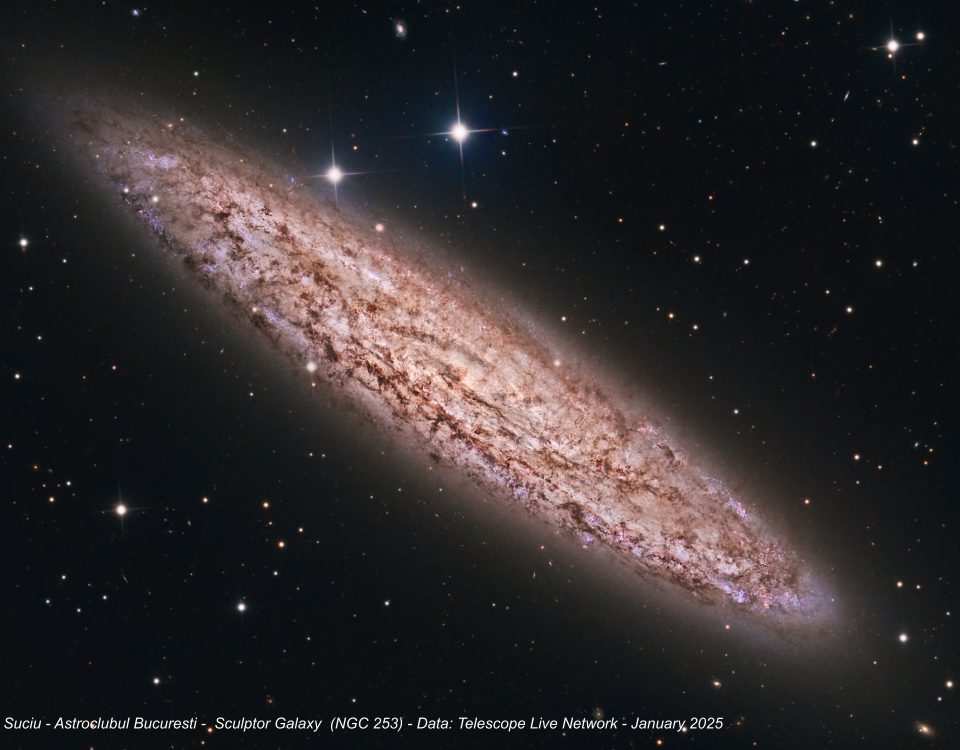M42, Nebuloasa Orion de Răzvan Orbu

Noțiuni de fotometrie și astrometrie – asteroizi și exoplanete de Dr. Marcel M. Popescu și Tiberiu Savin
februarie 9, 2025
Bazele spectroscopiei cu Marian Naiman și Daniel Berteșteanu
februarie 12, 2025Data publicării : 11 februarie 2025
M42, NEBULOASA ORION sau cea mai fotografiată țintă de cer profund
Pentru că se află la distanța de 1500 ani lumină de Pământ, pentru că este luminoasă și acoperă o zonă însemnată de cer, această nebuloasă este ținta tuturor celor care s-au aventurat în astrofotografie. Nebuloasa Orion este generoasă, se arată în ambele emisfere, spre deosebire de Nebuloasa Carina care rămâne credincioasă emisferei sudice.
În esență această nebuloasă este o zonă în care se formează stele. E cea mai apropiată de Terra și fiind vizibilă și maiestuoasă, vechii Mayași au denumit-o Focul Cosmic al Creației.
Nebuloasa include un cluster deschis de stele tinere, patru dintre ele formând un asterism numit Trapezium, întins pe o distanță de 1,5 ani lumină. Cele patru stele emit radiații în spectrul ultraviolet care afectează procesul de formare a stelelor în proximitatea lor.
Însă intensitatea și amploarea fenomenelor din nebuloasă, a cărei dimensiune este de aproximativ 25 de ani lumină oferă prilejul studierii modului în care se formează stelele și sisteme planetare. Astronomii au observat discuri protoplanetare, pitice maro, mișcări de gaze cosmice și au studiat efectul foto ionizant produs de stelele masive din apropierea nebuloasei.
M42 se poate vedea și cu ochiul liber, este ușor de localizat iar în perioada de toamnă-iarnă putem realiza expuneri și fotografii spectaculoase. Având un centru mult mai luminos decât restul nebuloasei, este oarecum dificil să o prezentăm în integralitate fără un oarecare efort. Fotografia atașată este realizată prin procesarea unor cadre luminoase care au timpi de expunere diferiți: 10, 45, 60 , 90, 120 și 300 secunde. Timpul total de integrare este 1 oră și 57 de minute. Camera utilizată este SV605CC, echipată cu chipset IMX533. Dimensiunea senzorului permite încadrarea completă a țintei. Cadrele luminoase au fost trase cu fitru dual band care permite trecerea doar a benzilor Ha și OIII.
Procesarea a fost făcută în Pixinsight, unde reginele fluxului au fost HDR Composition și HDR Multiscale Transformation (pentru evidențierea formațiunii Trapezium). Am ales să separ canalele de culoare și să le recombin în PixelMath în modul HOO. Măștile de culoare în combinație cu procesul Curves Transformation au definit imaginea prezentată.
Autor text și foto: Răzvan Orbu, Astroclubul București, România
M42, the Orion Nebula, or the Most Photographed Deep-Sky Target
Because it is located 1,500 light-years away from Earth, because it is bright and covers a significant area of the sky, this nebula is the target of everyone who has ventured into astrophotography. The Orion Nebula is generous, visible in both hemispheres, unlike the Carina Nebula, which remains loyal to the southern hemisphere.
Essentially, this nebula is a star-forming region. It is the closest to Earth and, being visible and majestic, the ancient Mayans called it the Cosmic Fire of Creation.
The nebula includes an open cluster of young stars, four of which form an asterism called the Trapezium, spanning a distance of 1.5 light-years. These four stars emit ultraviolet radiation that affects the star formation process in their vicinity.
However, the intensity and scale of the phenomena within the nebula, which spans approximately 25 light-years, provide an opportunity to study how stars and planetary systems form. Astronomers have observed protoplanetary disks, brown dwarfs, movements of cosmic gases, and have studied the photoionization effect produced by massive stars near the nebula.
M42 can be seen with the naked eye, is easy to locate, and during the autumn-winter period, we can capture spectacular exposures and photographs. Having a much brighter center than the rest of the nebula, it is somewhat challenging to present it in its entirety without some effort. The attached photograph was created by processing frames with different exposure times: 10, 45, 60, 90, 120, and 300 seconds. The total integration time is 1 hour and 57 minutes. The camera used is the SV605CC, equipped with an IMX533 chipset. The size of the sensor allows for complete framing of the target. The light frames were captured using a dual-band filter that allows the passage only of Ha and OIII bands.
Processing was done in PixInsight, where the queens of the workflow were HDR Composition and HDR Multiscale Transformation (to highlight the Trapezium formation). I chose to separate the color channels and recombine them in PixelMath using the HOO method. Color masks in combination with the Curves Transformation process defined the final image presented.
Author text and photo: Răzvan Orbu, Bucharest Astroclub, Romania




